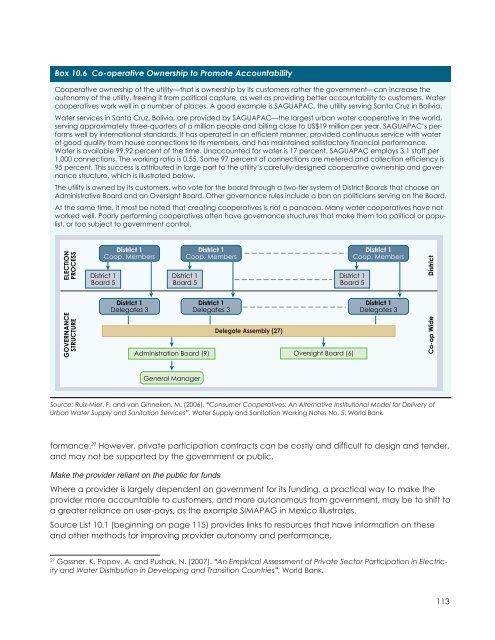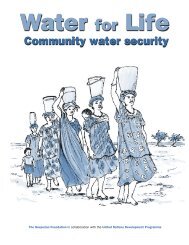A Sourcebook - UN-Water
A Sourcebook - UN-Water
A Sourcebook - UN-Water
Create successful ePaper yourself
Turn your PDF publications into a flip-book with our unique Google optimized e-Paper software.
Box 10.6 Co-operative Ownership to Promote Accountability<br />
Cooperative ownership of the utility—that is ownership by its customers rather the government—can increase the<br />
autonomy of the utility, freeing it from political capture, as well as providing better accountability to customers. <strong>Water</strong><br />
cooperatives work well in a number of places. A good example is SAGUAPAC, the utility serving Santa Cruz in Bolivia.<br />
<strong>Water</strong> services in Santa Cruz, Bolivia, are provided by SAGUAPAC—the largest urban water cooperative in the world,<br />
serving approximately three-quarters of a million people and billing close to US$19 million per year. SAGUAPAC’s performs<br />
well by international standards. It has operated in an efficient manner, provided continuous service with water<br />
of good quality from house connections to its members, and has maintained satisfactory financial performance.<br />
<strong>Water</strong> is available 99.92 percent of the time. Unaccounted for water is 17 percent. SAGUAPAC employs 3.1 staff per<br />
1,000 connections. The working ratio is 0.55. Some 97 percent of connections are metered and collection efficiency is<br />
95 percent. This success is attributed in large part to the utility’s carefully-designed cooperative ownership and governance<br />
structure, which is illustrated below.<br />
The utility is owned by its customers, who vote for the board through a two-tier system of District Boards that choose an<br />
Administrative Board and an Oversight Board. Other governance rules include a ban on politicians serving on the Board.<br />
At the same time, it most be noted that creating cooperatives is not a panacea. Many water cooperatives have not<br />
worked well. Poorly performing cooperatives often have governance structures that make them too political or populist,<br />
or too subject to government control.<br />
ELECTION<br />
PROCESS<br />
GOVERNANCE<br />
STRUCTURE<br />
District 1<br />
Coop. Members<br />
District 1<br />
Board 5<br />
District 1<br />
Delegates 3<br />
District 1<br />
Coop. Members<br />
District 1<br />
Board 5<br />
District 1<br />
Delegates 3<br />
Delegate Assembly (27)<br />
Administration Board (9) Oversight Board (6)<br />
District 1<br />
Coop. Members<br />
District 1<br />
Board 5<br />
District 1<br />
Delegates 3<br />
Co-op Wide District<br />
General Manager<br />
Source: Ruiz-Mier, F. and van Ginneken, M. (2006). “Consumer Cooperatives: An Alternative Institutional Model for Delivery of<br />
Urban <strong>Water</strong> Supply and Sanitation Services”. <strong>Water</strong> Supply and Sanitation Working Notes No. 5. World Bank<br />
formance. 27 However, private participation contracts can be costly and difficult to design and tender,<br />
and may not be supported by the government or public.<br />
Make the provider reliant on the public for funds<br />
Where a provider is largely dependent on government for its funding, a practical way to make the<br />
provider more accountable to customers, and more autonomous from government, may be to shift to<br />
a greater reliance on user-pays, as the example SIMAPAG in Mexico illustrates.<br />
Source List 10.1 (beginning on page 115) provides links to resources that have information on these<br />
and other methods for improving provider autonomy and performance.<br />
27<br />
Gassner, K. Popov, A. and Pushak, N. (2007). “An Empirical Assessment of Private Sector Participation in Electricity<br />
and <strong>Water</strong> Distribution in Developing and Transition Countries”. World Bank.<br />
113
















